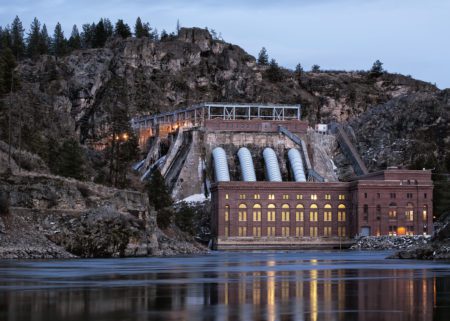
More than 100 years ago, the 88 MW Long Lake hydro plant was completed on the Spokane River in Washington State, U.S. The plant, owned by Avista, was built to serve rural communities and provide power for mining operations. The dam stands 213 feet high and is located where the river makes a horseshoe bend and passes through a canyon with tall granite walls. When it was built, it was the world’s highest spillway dam with the largest turbines then in use. Because of its historic significance, the property was nominated to the National Register of Historic Places in 1988.
In 2022, the Long Lake hydroelectric plant was inducted into the Hydro Hall of Fame at HYDROVISION International. Read on to learn more about the story of this historic hydropower facility, and its bright future.
 Hydro Hall of Fame
Hydro Hall of Fame Making history
The dust kicks up in small clouds behind the hooves of the horse team as they transport the covered wagon carrying a transformer to the construction site of Long Lake Dam. The year is 1911, and the roads to the site on the Spokane River in Washington State are rudimentary at best. The journey is slow, and the wagoner navigates the team along a treacherous stretch that slopes steeply away from the hillside. It’s dry and hot, and the dam at Long Lake is about a year into its construction. They are building the world’s highest spillway dam with the largest turbines to date, with an innovative in-house design dating to the early 1900s. The work is taxing, difficult and at times harrowing. The results will be stunning.

The site is naturally suited for hydroelectric development. As the Spokane River makes a horseshoe bend, it passes through a canyon with tall granite walls, providing an ideal location to build a dam. Between 1910 and 1915, more than 500 workers employed by Washington Water Power (WWP), now Avista, will build a dam and contribute to the doubling of the company’s generating capacity and extend electrical service to rural communities. The dam will also provide power for mining operations.
In short, the Long Lake Dam will play a vital role in the economic development of eastern Washington and northern Idaho. Today, it is part of a system of hydroelectric facilities owned and operated by Avista on the Spokane River.
Keeping it modern
Although some of the structures along the top of the dam were updated over the years, the dam and powerhouse remain largely unchanged. The engineering conceived by the employees involved in the design of the dam in the early 1900s reflects the state-of-the-art hydroelectric technology of the early 20th century.
While the history of Long Lake Dam is rich and noteworthy, its future looks promising, as well. Recently, Avista has performed several projects to extend the operating life of the hydro projects.
When the facility was 100 years old, Avista invested in work to reline the 16-foot-diameter penstocks that deliver water to the four turbine-generator units. The 236-foot-long penstocks are made of riveted steel pipe and hadn’t been lined since coal tar epoxy was applied in 1913. Heavy pitting and rust scale were present across the pipe surface. To minimize the impact on the surrounding Columbia River watershed system, Avista used a DuraShield 310 polyurethane product, recognized by the U.S. Department of Agriculture as a Certified Biobased Product.
Beginning in 2016, Avista, working with the Department of Ecology, Spokane Tribe, and many other stakeholders, began examining ways of improving river conditions at the dam for the benefit of the fish living downstream. Water testing below the dam showed elevated levels of dissolved gases in the river during times the dam spills a lot of water. Supersaturation of dissolved gas can cause bubble trauma in fish, resulting in injury or mortality. Production of total dissolved gas is a complex process but is affected by the amount of air entrained in the spillway and during plunging of spillway flows.
Avista installed deflectors on the lower face of Long Lake Dam to make the water skim instead of plunge at the dam’s base, and at the same time the depth of the dam’s plunge pool was reduced and rock at a nearby outcropping removed so it would not obstruct the flow of the river. Together, these changes are lowering dissolved gas levels in the water and keep the fish healthy.
In January 2022, Avista contracted work to rehabilitate and modernize the four generator units at Long Lake, as they were installed in the late 1970s and have a 40-year design life. The project scope includes the complete renewal and supply of the stators, poles, fans and spider/rim designs. The main objective of the refurbishment is to maintain the overall plant equipment reliability for decades to come. When the refurbishment is complete, the facility will have an installed capacity exceeding 100 MW. The first modernized unit is scheduled to go into operation at the end of 2024 and the last one in 2029.
In addition, modernizing the units will increase the efficiency and performance and respond to the growing needs of the western energy imbalance market (EIM) to better serve Avista’s customers. The EIM is a real-time wholesale energy trading market that enables participants anywhere in the western U.S. to buy and sell energy when needed, maintaining grid reliability and making excess renewable energy available to participating utilities at low cost rather than turning the generating units off.
Hydropower changed lives by bringing clean, renewable and abundant amounts of electric power to many people, and many for the first time, at the turn of the 20th century. Today, it remains an important part of Avista’s clean, renewable energy future. Long Lake Dam will continue to contribute to this future.